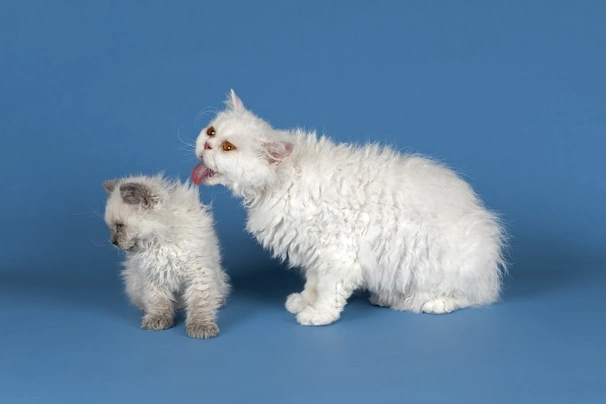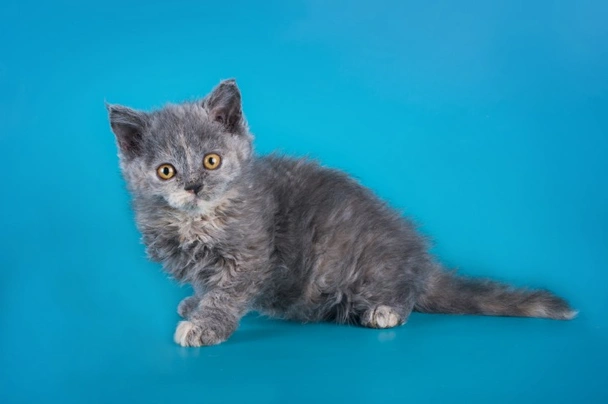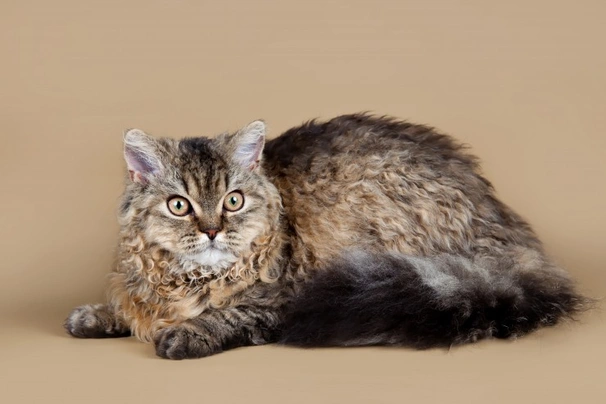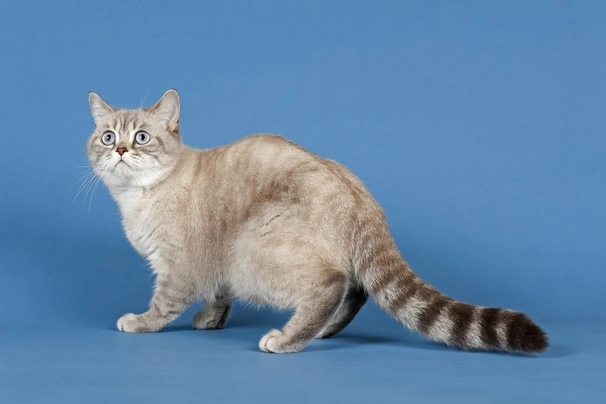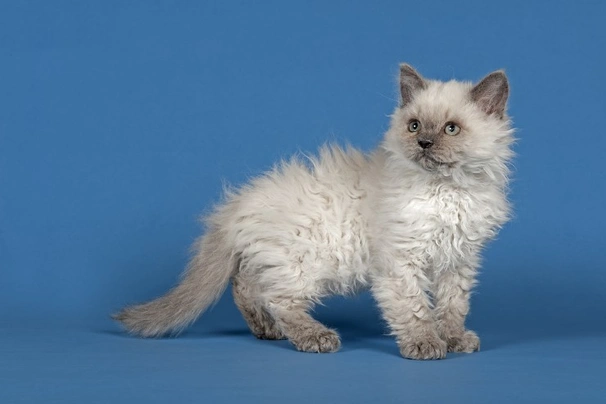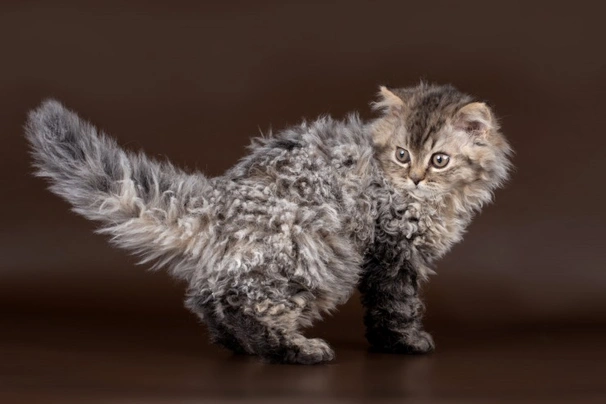Selkirk Rex
Introduction of the Selkirk Rex
The Selkirk Rex was first developed in the United States and since they first appeared on the scene these charming cats quickly became known as wonderful companions and family pets. They boast having extremely laid back personalities and are the biggest of the "rex" type curly coated breeds. Often referred to as the cat in sheep's clothing the Selkirk Rex is a joy to share a home with thanks to their placid and ultra-affectionate natures.
History of the Selkirk Rex
The Selkirk Rex is a relative newcomer to the cat world having been first developed in the United States during the late 1980s. It all happened quite by accident to begin with when one female kitten in a litter was born with an unusual curly coat the mother being a rescue cat but it was unsure who the father was. A breeder interested in genetics adopted the kitten and when she was old enough crossed her with a black Persian male. The mating produced six kittens three with curly coats and three with straight coats. In time the mutation that caused the cat's hair to be curly was seen to be a dominant gene but it was also established that the original cat also carried the recessive gene responsible for the longer hair too.
Because they boast this dominant gene the Selkirk Rex even when mated to other cats will produce "rex" coated kittens with around half of them being born with curly coats. With the breed being so new good records have been kept right from the word go. As such all the Selkirk Rex seen today can be traced back to this one female curly coated kitten who went by the name of Miss dePesto or Pest for short. It was not until 2002 that the very first Selkirk Rex cats landed on UK shores when they were imported from Austria. The following year the breed earned preliminary recognition from the GCCF and full Championship status was awarded the Selkirk Rex in 2009. Today The Selkirk Rex is a popular choice both as a companion and family pet thanks to their charming looks and kind affectionate natures.
Appearance of the Selkirk Rex
The Selkirk Rex can have either short or long hair with the shorter coated cats boasting a dense luxurious curl in their coats which gives them a teddy-bear like look. Longhaired carts have a more tousled look about them and their coat resembles that of a sheep. Kittens are born with curly coats whether they have long or short hair but they can lose their curls which then develop again when they are around 10 months old.
They are medium to large in size showing a good amount of bone that adds to a cat's weight and powerful appearance. However females tend to be that much smaller than their male counterparts and the curliness of a cat's coat rather depends on their age the time of year and their gender. They have nice broad rounded heads with lovely full cheeks. They have rounded foreheads with a slight curve at the top. Cats have a lovely rectangular shaped muzzle which is well padded and their whiskers are either curly or broken which adds to their endearing appearance.
The Selkirk Rex has a short straight broad nose that boasts having a downward slant to it. When seen in profile a cat's nose may look as if it has a convex curve to it. They have well developed firm chins and nice level bites. Their ears are medium in size and can be tufted being set well apart on a cat's head. If a cat has internal furnishings in their ears these are gorgeously curly. Their eyes are lovely and round being large and nicely opened. Eyes are set well apart on a cat's head and can be any colour.
They have quite cobby type bodies with nice level backs which can have a gentle rise to a cat’s powerful and heavy hindquarters. Cats are broad across the shoulders and rumps are large. Their legs are moderately long showing a good amount of bone and paws are firm and rounded. They have thick moderately long tails that are thicker at the base and which boast having a rounded tip to them.
When it comes to their coat the shorthair Selkirk Rex boasts having a thick dense coat that covers their entire bodies with the hair around a cat's neck and tail being the same length as the rest of their bodies which results in it being close lying. Longhaired cats have semi-long hair and they have curly tails where the hair stands well off it. They also have a charming ruff around their necks that also frames a cat's face. Their coats are unstructured being loose individual curls which results in them having a soft and luxurious appearance. A cat's neck belly and tail tends to have the curliest hair. The Selkirk Rex comes in all colours patterns and combinations which includes cats having white markings on any type of coat.
Temperament of the Selkirk Rex
Like a lot of other breeds the Selkirk Rex likes a routine and doesn't particularly like it when this changes for any reason. They like to be fed at the same time of the day and don't appreciate it when furniture gets moved around the home. With this said they are known to be extremely loving cats which is inherited from both parent breeds which boast having kind natures. They are laid-back by nature and tolerant which is one of the reasons why they have become such popular family pets.
They have the "cuddliness" of the Persian and the "cheekiness" of the Exotic Shorthair and they form extremely strong bonds with their owners. As such they hate being left on their own for any length of time. Selkirks are best suited to families where at least one person stays at home when everyone else is out of the house. They are social cats and typically get on well with everybody which includes the family dog and other pets. They are also known to be tolerant around children of all ages. They can be quite chatty although they have soft quiet voices but a Selkirk Rex is always ready and willing to hold a conversation with the people they love and let them know when it is meal time.
Intelligence / Trainability of the Selkirk Rex
The Selkirk Rex is a smart cat and one that enjoys playing interactive games. They have a very clown-like side to their natures which just adds to their endearing personalities. They may not be as intelligent as some other breeds but a Selkirk Rex quickly learns how to open doors or cupboards and likes to be given things to do to keep their minds occupied when they are not cat napping that is. They thrive on being around people and if left alone for any length of time it’s important for them to have lots of things to keep them occupied and to prevent boredom and stress setting in.
Children and other
With their outgoing affectionate personalities the Selkirk Rex is the perfect choice for families with children because of their playful tolerant natures. However care has to be taken when very young children are around cats and any interaction should always be supervised by an adult to make sure things stay nice and calm. With this said younger children need to be taught how to behave around cats and when it is time to leave them alone.
They also get on well with dogs especially if they have grown up together. However care has to be taken when introducing a Selkirk Rex to dogs they don't already know just in case the dog does not get on with their feline counterparts. They are incredibly social by nature and have been known to get on with small animals. However it's always wiser to keep a close eye on any cat when they are around smaller pets particularly when they first meet each other just to be on the safe side.
Health of the Selkirk Rex
The average life expectancy of a Selkirk Rex is between 10 and 15 years when properly cared for and fed an appropriate good quality diet to suit their ages.
The Selkirk Rex is known to suffer from a few hereditary health issues which are worth knowing about if you are planning share your home with one of these lovely looking curly coated cats. The conditions that seem to affect the breed the most include the following:
- Polycystic Kidney Disease (PKD) - breeders should have stud cats DNA tested
- Hypertrophic Cardiomyopathy (HCM) - breeders should have stud cats DNA tested
Caring for the Selkirk Rex
As with any other breed a Selkirk Rex needs to be groomed on a regular basis to make sure their coats and skin are kept in top condition. On top of this cats need to be fed good quality food that meets all their nutritional needs throughout their lives which is especially true of kittens and older cats.
Grooming of the Selkirk Rex
A Selkirk Rex can boast having a short close lying coat or a semi-long loose curly coat. Cats with short hair need less in the way of grooming than their longhaired counterparts. A weekly brush is all it takes to keep their coats in good condition. Longer haired Selkirks are higher maintenance on the grooming front and need to be brushed several times a week to prevent tangles and knots from forming. However it's important not to "over groom" a cat. It's also worth bearing in mind that some cats have a bit of a greasy feel to their coat which is perfectly natural.
Like other cats they tend to shed the most in the Spring and then again in the Autumn when more frequent brushing is usually necessary to keep on top of things. It's also important to check a cat's ears on a regular basis and to clean them when necessary. If too much wax is allowed to build up it can lead to a painful infection which can be hard to clear up. In short prevention is often easier than cure with ear infections. Cats often suffer from ear mites which can be a real problem which is why it's so important to check their ears on a regular basis.
Exercise of the Selkirk Rex
The Selkirk Rex may be a laid back tolerant cat by nature but they also boast having a bit of cheeky streak in them. They adore playing interactive games which includes activities like "fetch". However they are not overly demanding and are just as happy to curl up on a lap once the games are over. With this said cats kept as indoor pets need to be given lots of things to do and places to hide when they want to bearing in mind that the Selkirk loves to climb up high so they can look down on the world below. They also need to have lots of places they can snuggle up for a snooze when the mood takes them because if there is one thing the Selkirk really enjoys it's snoozing during the day.
Feeding of the Selkirk Rex
If you get a Selkirk Rex kitten from a breeder they would give you a feeding schedule and it's important to stick to the same routine feeding the same kitten food to avoid any tummy upsets. You can change a kitten's diet but this needs to be done very gradually always making sure they don't develop any digestive upsets and if they do it's best to put them back on their original diet and to discuss things with the vet before attempting to change it again.
Older cats are not known to be fussy eaters but this does not mean they can be given a lower quality diet. It's best to feed a mature cat several times a day making sure it's good quality food that meets all their nutritional requirements which is especially important as cats get older. It's also essential to keep an eye on a cat's weight because if they start to put on too much it can have a serious impact on their overall health and wellbeing. Like all other breeds the Selkirk needs access to fresh clean water at all times.
Selkirk Rex price
If you are looking to buy a Selkirk Rex you would need to pay anything from £300 to well over £600 for a well-bred pedigree kitten. The cost of insuring a male 3-year-old Selkirk Rex in northern England would be £11.67 a month for basic cover but for a lifetime policy this would set you back £24.07 a month (quote as of October 2016). When insurance companies calculate a pet's premium they factor in several things which includes where you live in the UK a cat's age and whether or not they have been neutered or spayed among other things.
When it comes to food costs you need to buy the best quality food whether wet or dry making sure it suits the different stages of a cat’s life. This would set you back between £15 - £20 a month. On top of all of this you need to factor in veterinary costs if you want to share your home with a Selkirk and this includes their initial vaccinations their annual boosters the cost of neutering or spaying a cat when the time is right and their yearly health checks all of which quickly adds up to over £600 a year.
As a rough guide the average cost to keep and care for a Selkirk Rex would be between £25 to £55 a month depending on the level of insurance cover you opt to buy for your cat but this does not include the initial cost of buying a well-bred kitten.

Selkirk Rex Kittens
£750
